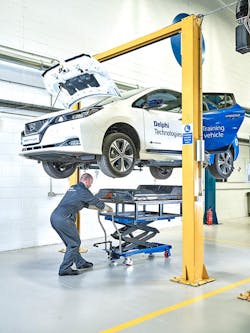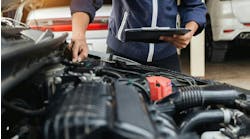Content brought to you by Auto Body Repair Network. To subscribe, click here.
The influx of electric vehicles (EVs) is bringing new challenges to collision repairers. We have all seen the statistics surrounding the increase of them on our roads. Manufacturers are advertising that a majority of their offerings will be fully electric or hybrid within the next several years.
Are you prepared to handle accident-damaged electric vehicles? Even though the Prius has been around for a while, I have not seen defined processes in all shops relating to EV repairs. I have talked with some who suggest it is just body work, and while they might be partially correct, they are also dangerously wrong. Handling damaged EVs is very different than any vehicle a shop has previously repaired.
Before you begin repairing EVs, you will need some very specific equipment. Beginning with safety, the most obvious is the rescue hook. While it might look like something you would find near a swimming pool, it is quite different and a very essential piece of equipment. In addition to the hook, you will need insulated gloves, face shields, and aprons. It is also recommended you have barrier posts and chains to isolate the area where an EV is being repaired. There are also specially insulated screwdrivers, wrenches and socket sets required when working around the battery and electrical connections. A review of Ford’s tool recommendation for certified shops includes a high-voltage lift table, engine crane with battery lifting attachments, and a lift capable of raising an EV safely.
Even with all the right equipment, working around an EV requires particular attention and knowledge of the vehicle’s systems. Even moving a damaged EV into your repair facility could be hazardous. To help shops ensure they operate in a safe manner, I-CAR has several course offerings and created a best-practice safety protocol checklist which is available on its website. This eight-page document includes steps identified by the OEM to render the vehicle safe and ready for repairs to be initiated. Using this checklist along with OEM repair procedures allows a repair facility to operate safely and protect its facility and employees.
Making a vehicle safe for repairs is only the first step. Similar to working around the myriad of airbags in vehicles today, there are specific procedures related to the electrical components unique to EVs. OEM repair procedures dictate what repairs can be completed with the high-voltage battery in place and those that require the battery to be removed. Those same requirements are presented for the charging systems and high-voltage cabling. A damage appraiser must thoroughly research these processes to ensure all steps are itemized within their appraisal. Missing a step in the OEM procedures could create a dangerous situation for those involved in the repair appraisal, and documentation is the key to communicating those requirements.
Refinishing an EV also brings new challenges. For example, Honda specifies that on its Honda Accord Hybrid, high temperatures may damage the battery, and booth temperatures must not exceed 150 degrees F (65 degrees C). With standard clearcoats requiring 140 degrees F metal temperature to cure properly, the booth temperature in most cases will exceed the Honda requirements. The damage appraiser must document the temperature restrictions so that the painter selects a no-bake or low-bake clearcoat to stay within the temperature parameters. On the other hand, Toyota indicates that on its Prius, there are no special precautions necessary. It states that while high temperatures could cause damage to the battery, there is no chance of reaching those temperatures during booth bake cycles. Seeing these two vastly different manufacturers requirements brings credence to the need for thorough research. Handling one vehicle like the other could create hazardous situations.
Repairing an EV isn’t for everyone, especially those who are not equipped and trained properly. This article mentions some key points, but it is not all-inclusive on how to prepare your shop and technicians for the influx of EVs. I hope I have given you enough information to understand there are differences between repairing a vehicle with a standard internal combustion engine and one with a high-voltage electrical system. The point I tried to relay is that the differences are dangerous and should be taken seriously, so if you are not prepared, please don’t try to repair them! There are plenty of other vehicles that need collision repair that will not jeopardize your shop or your people.



